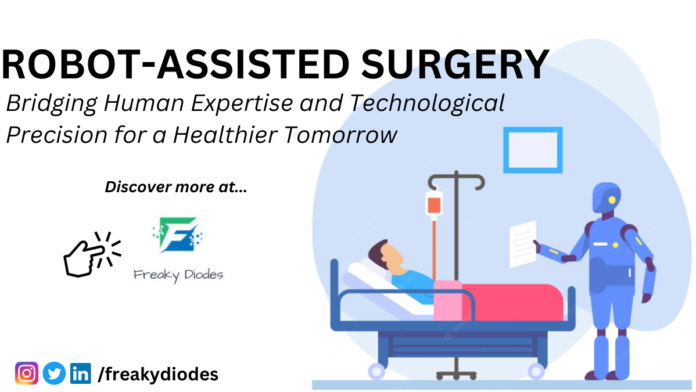Unlocking the Potential, Advantages, and Future of Robot-Assisted Surgery
🤖 In the rapidly advancing world of medicine, one extraordinary innovation is taking center stage: Robot-Assisted Surgery. This comprehensive exploration will delve deep into the transformative technology, examining its origins, intricate mechanisms, diverse applications, and the profound impact it’s having on the healthcare landscape today.
Robot-Assisted Surgery Unveiled
Robot-Assisted Surgery, also known as robotic surgery or computer-assisted surgery, represents a paradigm shift in the medical field. It’s the harmonious union of the unmatched precision and dexterity of robotics with the skill and experience of human surgeons. This collaboration leads to surgeries that are not only precise but also minimally invasive, resulting in quicker recoveries and better patient outcomes.
The core of a robotic surgical system typically consists of a console where the surgeon sits, immersed in a high-definition 3D view of the surgical field, and a set of robotic arms that replicate the surgeon’s hand movements with astonishing accuracy. This seamless synergy between human intelligence and mechanical precision is nothing short of awe-inspiring.
The Human-Robot Partnership
👨⚕️🤖 Imagine a surgeon, comfortably seated at the console, peering into a magnified, three-dimensional view of the surgical field. Their hand movements are translated into exact, scaled motions by the robotic arms. This harmonious partnership between human and machine is a testament to the limitless possibilities of modern medicine.
A Multitude of Applications
Robot-Assisted Surgery is not confined to a single medical specialty; it’s a versatile tool that benefits various disciplines:
- Urology: Within this field, robot-assisted surgeries are often employed for prostatectomies. These procedures see reduced blood loss and shorter recovery times compared to traditional surgeries.
- Gynecology: Conditions such as uterine fibroids and certain cancers can be treated using robot-assisted surgery, leading to smaller incisions, minimal scarring, and faster postoperative recovery.
- Cardiology: For heart surgeries, robots navigate intricate pathways with exceptional precision. This enhances the safety and efficiency of procedures like coronary artery bypass and valve surgeries.
- Orthopedics: Joint replacement surgeries benefit immensely from robotic assistance. These systems ensure the implant’s optimal alignment, which, in turn, improves patient mobility and the longevity of the implant.
- General Surgery: Procedures like colorectal surgeries and hernia repairs have also witnessed the integration of robot-assisted techniques, reducing the risk of complications.
Advantages of Robot-Assisted Surgery
🌟 Robot-Assisted Surgery offers a plethora of advantages, both for surgeons and patients:
- Minimally Invasive: Smaller incisions translate to less pain, reduced scarring, and quicker recovery times. Patients can often return to their normal lives sooner, enjoying an enhanced quality of life.
- Precision: Robots exhibit unparalleled precision, mitigating the risk of human error and ensuring accuracy in every movement. This precision is particularly valuable in delicate and complex surgeries.
- Enhanced Visualization: Surgeons benefit from a magnified, 3D view of the surgical area, enabling better decision-making during procedures. This enhanced visualization can be pivotal in critical surgeries.
- Reduced Blood Loss: The precision of robotic instruments leads to significantly reduced blood loss, enhancing patient safety and reducing the need for transfusions.
- Shorter Hospital Stays: Faster recovery times often mean shorter hospital stays, reducing healthcare costs and minimizing patient discomfort. This results in more efficient healthcare systems and happier patients.
Real-World Applications of Robot-Assisted Surgery
Here are some real-world examples of Robot-Assisted Surgery and the procedures they are commonly used for:
1. Da Vinci Surgical System (Intuitive Surgical):
- Procedure: Prostatectomy
- The Da Vinci Surgical System is a robotic marvel that assists surgeons in delicate prostatectomy procedures. With its precision, it minimizes the need for large incisions, leading to less pain and a quicker recovery. Patients roar back to health sooner with this robotic ally.
2. Mazor X (Medtronic):
- Procedure: Spine Surgery
- The Mazor X is like a space navigator for spine surgeons. It guides them with incredible precision during spinal fusion surgeries. This robotic assistant ensures that patients experience reduced risks and a smoother journey to recovery.
3. da Vinci Xi (Intuitive Surgical):
- Procedure: Gynecological Surgery
- Think of the da Vinci Xi as a gentle gardener for gynecological health. It aids surgeons in procedures like hysterectomies, making them less invasive and allowing patients to blossom back to normal life faster.
4. Stereotaxis Robotic Magnetic Navigation System:
- Procedure: Cardiac Electrophysiology
- This system is like a magnetic maestro for the heart’s rhythm. It navigates catheters with precision, orchestrating successful cardiac procedures. Patients’ hearts dance to the right tune with this robotic conductor.
5. Mako Robotic-Arm Assisted Surgery (Stryker):
- Procedure: Joint Replacement (e.g., knee and hip)
- Meet the Mako, your joint’s best friend! It assists surgeons in joint replacement surgeries, ensuring a perfect fit. Patients can look forward to a pain-free and active life with this robotic buddy by their side.
6. Senhance Surgical System (TransEnterix):
- Procedure: General Surgery (e.g., colorectal)
- The Senhance Surgical System is like a surgeon’s right hand in the operating room. It adds precision and 3D vision to general surgeries, resulting in better outcomes and quicker recoveries. With this technology, patients experience smoother surgical journeys.
7. ROSA Robotic Surgery Assistant (Medtronic):
- Procedure: Neurosurgery
- ROSA is like an artist’s brush for neurosurgeons. It assists in complex brain and spine surgeries, ensuring precise planning and execution. Patients can trust ROSA to paint a path to recovery with the utmost accuracy.
These robotic systems are the surgical superheroes of our time, enhancing the capabilities of skilled surgeons and bringing comfort and confidence to patients seeking various medical procedures. 🤖🏥💪
Safety Measures in Place
🔒 Safety is of paramount concern in Robot-Assisted Surgery. These systems undergo rigorous testing and validation to ensure optimal control and minimize the risk of accidents. Features like motion scaling and force feedback are integrated to enhance safety during procedures.
Mastering the Art: Surgeon Training
📚 Surgeons must undergo specialized training to operate robot-assisted systems effectively. Like any tool, mastery comes with practice. But once surgeons conquer the learning curve, the benefits for both the medical community and patients are immeasurable. This ongoing education ensures that the potential of robot-assisted surgery is harnessed to its fullest extent.
Looking Towards the Future
🚀 Robot-Assisted Surgery is far from reaching its full potential. Researchers are continually exploring ways to make these systems even more intuitive and versatile. In the not-so-distant future, we may witness robots performing surgeries remotely, allowing experts to operate on patients located thousands of miles away. The possibilities are both awe-inspiring and endless, and the trajectory of this technology is nothing short of exciting.
Conclusion: A Surgical Revolution
In an era where technology continually astounds us, Robot-Assisted Surgery stands as a testament to human ingenuity and innovation. It’s not just about robots; it’s about the remarkable collaboration between human expertise and technological advancement. Together, they’re shaping a healthier, more promising future. 🤖👨⚕️💪
Robot-Assisted Surgery represents the vanguard of medical progress, with its precision, reduced invasiveness, and superior outcomes redefining the surgical landscape. As it continues to evolve and mature, this remarkable technology will undoubtedly touch the lives of countless patients, making surgery safer, more efficient, and less intrusive. The future of medicine is here, and it’s robotic.
“It’s like having a surgical sidekick with nerves of steel and a surgeon’s sense of humor. Together, they navigate complex procedures, making it look so easy that even the robots crack a digital smile. Here’s to faster recoveries and a future where robots tell the best surgical jokes!”
“
🤖🌟😄💉
Furthermore, Consider Reading…
ISRO’s Aditya-L1 Solar Mission: Illuminating Mysteries of The Sun
From Setback to Success: Chandrayaan-3’s Triumphant Lunar Odyssey
Latest Opportunities
- Accenture Off Campus Drive 2024 | Hiring for Application Developer | Opportunity for 2024/2023/2022 Graduates
- Wipro Off Campus Drive 2024 | Opportunity for Graduates
- Yash Technologies Off Campus Drive 2024 | Opportunity for 2024 & 2023 Graduates
- Oracle Off-Campus Drive 2024 | Hiring for Software Engineer | Opportunity for 2024, 2023 & 2022 Graduates
- Hitachi Off Campus Drive 2024 | Freshers Hiring | Opportunity as Associate Analyst
Stay ahead in the game and never miss out on exciting opportunities! Follow our social media handles for the latest updates on jobs, internships, news, articles and projects. Join our vibrant community of tech enthusiasts to unlock your potential and discover a world of endless possibilities. Let’s embark on this journey together!
| Join Our Telegram Channel | Click Here |
| Join Our WhatsApp Group | Click Here |
| Follow us on LinkedIn | Click Here |
| Follow us on Facebook | Click Here |
| Follow us on Instagram | Click Here |








